Click on images to enlarge
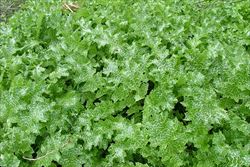
dense infestation of plants prior to flowering (Photo: Sheldon Navie)
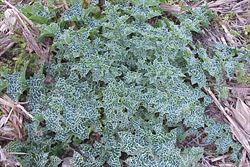
rosette of very large lower leaves (Photo: Sheldon Navie)

habit (Photo: Sheldon Navie)
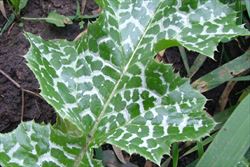
close-up of variegated leaf with deeply-lobed margins (Photo: Sheldon Navie)
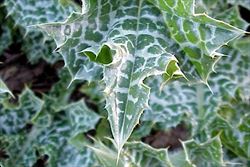
close-up of small spines on the margins and tips of the leaves (Photo: Sheldon Navie)
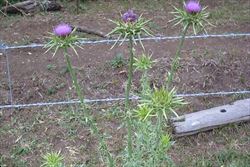
wingless stems and flower-heads (Photo: Sheldon Navie)
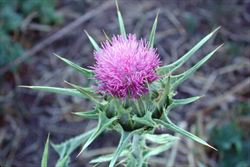
flower-head with very large spine-tipped bracts (Photo: Sheldon Navie)
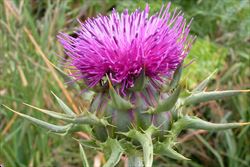
close-up of flower-head from side-on (Photo: Greg Jordan)

mature flower-head with fluffy seeds (Photo: Sheldon Navie)

close-up of seeds topped with numerous hairs (Photo: Sheldon Navie)
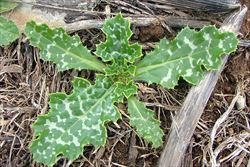
seedling (Photo: Sheldon Navie)
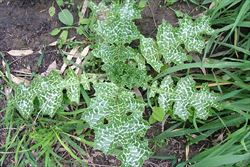
young plant (Photo: Sheldon Navie)
Scientific Name
Silybum marianum (L.) Gaertn.
Synonyms
Carduus marianus L.
Family
Asteraceae (Queensland, New South Wales, the ACT, Victoria, Tasmania, Western Australia and the Northern Territory)Compositae (South Australia)
Common Names
blessed milk thistle, blessed milk-thistle, blessed milkthistle, blessed thistle, bull thistle, cabbage thistle, Gundagai thistle, gundy, holy thistle, lady's thistle, Marian thistle, Mary's thistle, Marythistle, milk thistle, our lady's thistle, spotted milk thistle, spotted thistle, St. Mary's milk thistle, St. Mary's thistle, thistle, variegated artichoke, variegated thistle
Origin
Native to southern Europe (i.e. France, Portugal, Spain, Albania, Bulgaria, Greece, Italy and Yugoslavia), north-eastern Africa (i.e. Egypt) and western Asia.
Naturalised Distribution
Widely naturalised southern and eastern Australia (i.e. Queensland, New South Wales, the ACT, Victoria, Tasmania, many parts of South Australia and south-western Western Australia). It is most common in the coastal and sub-coastal regions of New South Wales and southern Victoria, and is relatively common in south-eastern South Australia, south-eastern Queensland, Tasmania and south-western Western Australia. Also present in other parts these states and naturalised on Lord Howe Island and Norfolk Island.
Widely naturalised overseas, including in other parts of Europe, tropical and southern Africa, New Zealand, North America (i.e. Canada and the USA), Central America and South America.
Habitat
A weed of crops and cultivation, pastures, forestry plantations, roadsides, disturbed sites and waste areas in temperate, sub-tropical and sometimes also semi-arid regions.
Habit
An upright (i.e. erect) and short-lived (i.e. annual or biennial) herbaceous plant usually growing 90-180 cm tall, but occasionally reaching up to 3 m in height. This species forms a large basal rosette of leaves during the early stages of growth.
Distinguishing Features
- an upright and short-lived thistle usually growing 90-180 cm tall.
- it forms a basal rosette of very large variegated leaves (25-60 long and 12-30 cm wide) at first.
- these leaves are variously lobed and armed with rigid yellowish-coloured spines (5-12 mm long) on their margins.
- its large purplish flower-heads (up to 13 cm across) are borne singly at the tips of the branches.
- these flower-heads possess several rows of large, stiff bracts (about 4 cm long) ending in large sharp spines.
- its relatively large mottled seeds (5-8 mm long) are topped with a tuft of numerous silky bristles (12-20 mm long).
Stems and Leaves
The branched stems are quite thick and are ribbed lengthwise (i.e. longitudinally). They are hairless (i.e. glabrous) or sparsely covered in cottony or downy hairs and do not have any spines or 'wings'.
The leaves are arranged in a basal rosette at first, and later alternately along the stems. They are shiny and have a distinctive variegated appearance (i.e. mottled green and cream or whitish), particularly on the upper surfaces. The upper surfaces are sparsely hairy (i.e. puberulent), while the lower surfaces are more densely hairy (i.e. pubescent). Leaf margins are variously divided or lobed (i.e. pinnatifid), irregularly toothed or somewhat wavy (i.e. undulating) and armed with rigid yellowish-coloured spines (5-12 mm long). The rosette leaves are very large (25-60 cm long and 12-30 wide) and lance-shaped (i.e. lanceolate) or relatively broad (i.e. elliptic) with obvious stalks (i.e. petioles), while the stem leaves are much shorter, narrower, more rigid, triangular in shape and stem-clasping (i.e. they are sessile).
Flowers and Fruit
The large flower-heads (up to 13 cm across) are usually borne singly at the tips of the branches on stalks (i.e. peduncles) up to 30 cm long. They consist of numerous purplish or reddish-purple coloured florets surrounded by several rows of large, stiff bracts (4-5 cm long). The outer layers of bracts end in long sharp spreading spines. Flowering occurs mostly during spring and early summer (i.e. from September to January).
The seeds are yellowish-brown in colour, with black streaks that give them a mottled appearance, and have a yellow collar at the top (5-8 mm long and about 3 mm wide). They are somewhat flattened and topped with a tuft (i.e. pappus) of numerous whitish, silky, bristles (12-20 mm long) that easily become detached.
Reproduction and Dispersal
This species reproduces almost entirely by seeds that are equipped with a large 'parachute' of bristles that enhances dispersal by wind.
Seeds are also spread as a contaminant of agricultural produce (e.g. fodder and grain) and to a lesser extent by water, animals, vehicles, machinery and in mud.
Environmental Impact
While variegated thistle (Silybum marianum) is mainly a weed of crops, pastures, roadsides and disturbed areas, it is also regarded as an environmental weed of some importance in New South Wales and Victoria.
Legislation
This species is declared under legislation in the following states and territories:
- Victoria: C7 - all reasonable steps must be taken to control the weed and prevent its spread (in the Glenelg, Corangamite, Port Phillip East, Goulburn, North East, West Gippsland and East Gippsland regions).
- South Australia: 3* - declared in Class 3k, a category for agricultural weeds. It is required to be controlled in part of the state only.
- Western Australia: P1 - the movement of this species or its seeds is prohibited (throughout the entire state), P2 - to be eradicated (throughout the majority of the state), P3 - a weed which cannot be eradicated in the short term, but must be kept under 'control' (in a minority of local authority areas), and P4 - it must be 'contained' (in the City of Albany, Bridgetown, Dardanup, Denmark, Donnybrook-Balingup, Manjimup and Plantagenet local authority areas). See the Western Australian Department of Agriculture and Food Declared Plant List at http://www.agric.wa.gov.au/ for more detailed information about which areas are covered by these declarations.
Management
For information on the management of this species see the following resources:
- the Victorian Department of Sustainability and Environment Landcare Note on this species, which is available online at http://www.dse.vic.gov.au.
- the Tasmanian Department of Primary Industries and Water weed service sheet on this species, which is available online at http://www.dpiw.tas.gov.au.
- the Western Australian Department of Agriculture and Food information page on this species, online at http://www.agric.wa.gov.au.
Similar Species
Variegated thistle (Silybum marianum) is relatively similar to several introduced thistles including artichoke thistle (Cynara cardunculus), Scotch thistle (Onopordum acanthium), Illyrian thistle (Onopordum illyricum), nodding thistle (Carduus nutans subsp. nutans), spear thistle (Cirsium vulgare), perennial thistle (Cirsium arvense) and the slender thistles (Carduus pycnocephalus and Carduus tenuiflorus). These species can be distinguished by the following differences:
- variegated thistle (Silybum marianum) has 'wingless' stems and variegated leaves. Its very large flower-heads (up to 13 cm across including the spines) have very large spines.
- artichoke thistle (Cynara cardunculus) has 'wingless' stems and greyish-green leaves. Its very large flower-heads (up to 13 cm across including the spines) have very large spines.
- Scotch thistle (Onopordum acanthium) has 'winged' stems and bluish-grey coloured (glaucous) leaves. Its moderately large flower-heads (2-6 cm across) have relatively small spines.
- Illyrian thistle (Onopordum illyricum) has 'winged' stems and whitish coloured leaves. Its moderately large flower-heads (up to 8 cm across) have relatively small downward-pointing (reflexed) spines.
- nodding thistle (Carduus nutans subsp. nutans) has 'winged' stems and greenish coloured leaves. Its moderately large flower-heads (4-8 cm across) 'nod' or droop distinctively as they mature and have purplish-coloured bracts that are tipped with relatively small spines.
- spear thistle (Cirsium vulgare) has 'winged' stems and greenish coloured leaves. Its moderately large flower-heads (3-5 cm across) have relatively small spines.
- perennial thistle (Cirsium arvense) has 'wingless' stems and greenish coloured leaves. Its small and slender flower-heads (0.8-2.5 cm across) have very short, purple-tipped spines.
- the slender thistles (Carduus pycnocephalus and Carduus tenuiflorus) have 'winged' stems and greenish coloured leaves. Its small and slender flower-heads (0.7-1.5 cm across) have relatively small spines.

